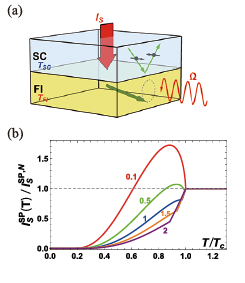Spin Injection from a Ferromagnetic Insulator into a Superconductor
M. Matsuo and T. Kato
Spin injection from a ferromagnetic metal into a superconductor (SC) has been investigated for a long time. For conventional s-wave superconductors, spin injection is suppressed by a SC energy gap. Thermally excited quasiparticles in SC, however, can carry injected spins over long distances, as spin excitations in SCs have long lifetimes. Several novel techniques for spin injection have been developed so far. For example, the spin injection can be realized by the spin Seebeck effect under a temperature gradient, or by applying a spin pumping protocol using ferromagnetic resonance (FMR) under microwave irradiation.

Fig. 1. (a) A schematic of the bilayer system composed of a superconductor (SC) and a ferromagnetic insulator (FI). (b) The temperature dependence of the spin current induced by spin pumping under microwave irradiation. The curves correspond to ħΩ/kBTC =0.1, 0.5, 1, 1.5, and 2 from the top to the bottom.
Recently, spin injection from a ferromagnetic insulator (FI) into a SC has also been performed [1]. Although this study opens up possible applications for novel superconducting spintronic devices using FI, spin injection from a FI has been studied theoretically only in Ref. [2] in the context of the damping in the FMR experiments. In the present study [3], we considered a bilayer system composed of a s-wave singlet SC and a FI as shown in Fig. 1(a), and calculated the spin current induced by the spin Seebeck effect or spin pumping, using the perturbation theory with respect to the interface exchange interaction.
In Fig. 1(b), we show the temperature dependence of the spin current induced by spin pumping. Here the temperature of the bilayer system and the spin current are normalized by the SC transition temperatures TC and the spin current for a normal metal, respectively. For small excitation frequency Ω, the spin current is enhanced below the SC transition temperature due to a coherent factor in analogy with the NMR measurement. For ħΩ < 2Δ(T = 0) ≈ 3.54kBTC, the spin current is strongly reduced at low temperatures (kBT≪ 2Δ(T), because spin-flip excitations in the SC are suppressed due to the energy gap 2Δ in the one-electron excitation spectrum, where Δ(T) is the SC energy gap (a function of the temperature T). As Ω increases, the coherence peak becomes insignificant, while there appears a kink at the temperature satisfying 2Δ(T) = ħΩ. For ħΩ > 2Δ(T = 0), the spin current shows a plateau at a low temperature corresponding to its zero temperature value, ultimately recovering the normal state value (dashed line) as Ω increases further. We also calculated the spin current induced by the spin Seebeck effect (not shown here), and discussed the effect of the SC transition.
For a realistic experimental setup, we estimated the noise power of the pure spin current following the theory developed in Ref. [4]. We have shown that the nonequilibrium spin-current noise in spin pumping experiments is much larger than the thermal noise at low temperatures, and that both noises show a coherent peak below the SC transition temperature. Finally, we proposed a possible experimental setup to measure the spin current and its noise obtained here, utilizing the inverse spin Hall effect in SCs.
This study has been performed as a joint study extended from the previous study [4] with Mamoru Matsuo, who was a visiting professor of ISSP in the academic year 2016. This study has also been performed as a collaborated project with the French group (the leader is Thierry Martin at Aix Marseille Univ., CPT, Marseille).
References
- [1] M. Umeda et al., App. Phys. Lett. 112, 232601 (2018).
- [2] M. Inoue, M. Ichioka, and H. Adachi, Phys. Rev. B 96, 024414 (2017).
- [3] T. Kato, Y. Ohnuma, M. Matsuo, J. Rech, T. Jonckheere, and T. Martin, Phys. Rev. B 99, 144411 (2019).
- [4] M. Matsuo, Y. Ohnuma, T. Kato, and S. Maekawa, Phys. Rev. Lett. 120, 037201 (2018).
